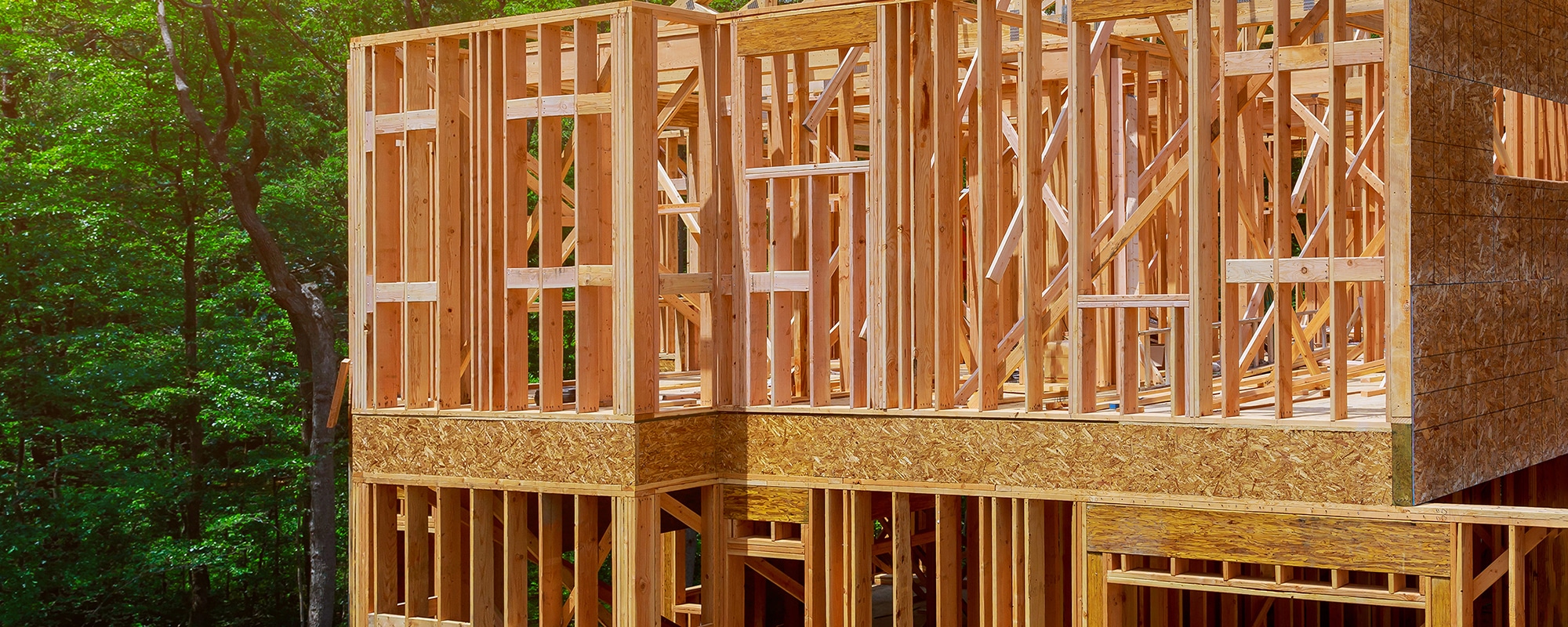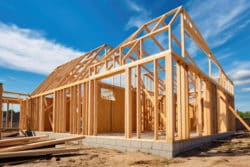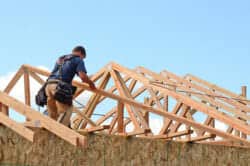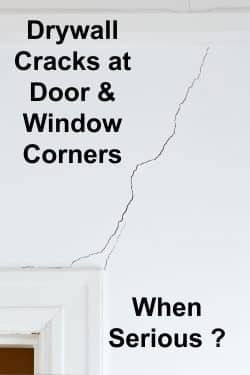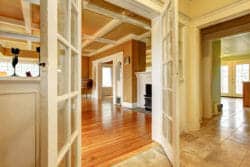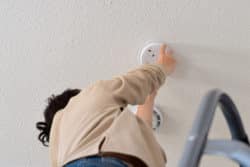Drywall Cracks In a New House | When Typical and When Serious

Drywall cracks are common in the first year or two in new houses; knowing which drywall cracks are typical and which are serious is important; know what to look for.
Determining the seriousness depends on a number of factors: including
- The number of cracks
- Location of the cracks
- Size of the cracks
- The cause of the cracks
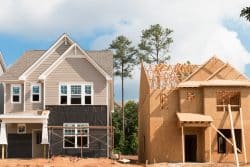
Check your “Home Builders’ Warranty”
Drywall cracks are common in new homes and builders know this and usually include repairing them for free in the first year as part of their “Home Warranty Guarantee.” Doing so builds goodwill and makes new home buyers happier with their purchase.
Many builders do a walk around with buyers just before they move in and a few after 30 days. Regardless, whether a walk around is done, it is wise to notify the builder about any drywall cracking (in writing) when and if they appear and be careful that you do not wait until after the warranty period has expired. This is true with any other issues with the home as well. Mark your calendar and remember that at times having photos, dates and location of where the cracks are can be helpful.
Note, some builders may be slow in patching drywall cracks if they appear in the first few months, but prefer to wait until sometime in the eleventh month, otherwise they might have to come out two or three times to do patching and would prefer to come out just once near the end of the warranty period for it cost then less money and visits doing it that way.
Settlement of a home in the first couple of years

It is not uncommon for homes to settle over their life and there is a tendency for many new homes to experience some settling in the first year or two after the home has been built.
Houses settle – they’re heavy
- Houses are very heavy and will tend to settle some in the first couple of years. The amount of settlement will depend on a number of factors, including:
- Weight of the materials used in the construction
- Size of the foundation and materials used
- Type of soil, for poorer quality of soils will not support as much weight as better-quality soils
- Compaction: if the soils were not properly compacted, the weight of the house will cause more settlement

Just how much do houses weigh?
Contractors will often use a rough rule of thumb of 200 pounds per square foot for the average single-story house or 275 pounds per square foot for a two story house, however, the weight will vary greatly depending on the type of materials used in constructing the home. A house with a concrete tile roof, brick siding, ceramic floor tiles, brick fireplace and granite counter tops will weigh a lot more than a house with a wood shake roof, wood siding, carpeted floors and laminated counter tops.
If a house weighs 200 pounds per square foot and it is a 2,000 s.f. house, you may be talking in the range of 400,000 pounds of pressure (or more) pushing downward on the soil, so it’s easy to see why there may be some settlement. A little settlement is natural, but if the soil shifts, if it’s expansive soil or the home is on a hillside and there is slope creep, then there is a higher likelihood of drywall cracking and a higher level of concern.
All other things being equal, the heavier the house, the more likely it is to settle.
Which type of settling is worst?
- Uniform
- Tipping
- Differential
Of the three basic types of settling, differential settlement will usually cause the most cracking of the three typical types of settlement. Uniform settlement usually causes the least amount of drywall cracking. The reason that differential settlement causes the most drywall cracks and damage is that it places the greatest amount of stress on the wood framing under the drywall and if the framing moves, twist or shifts about, then the stresses caused by this will crack the drywall. (Read more about houses settling)
Framing, moisture and wood shrinkage issues in the first year
Who knew? A home may lose 1/4 to 3/4 of an inch in height in the first year
Excluding settlement, just wood shrinkage that occurs in a home the first year may shorten the height of a home by 1/4 to 3/4 of an inch, depending on how the home was framed and the moisture content of the lumber used. This alone may cause a small amount of drywall cracking as well as a few other issues.
Wood Shrinkage at ceiling and floor joist headers
Wood tends to shrink when it dries and expands when it gets wet. When wood dries, it often warps, bows, cups, as well as shrinks; this then often causes drywall cracks and sometimes drywall nail heads to pop-out.
There are certain framing members or components in a new home where the wood shrinkage is more likely to cause cracking, these include:
- Headers over doors, windows, wall openings between rooms and headers over garage doors.
- Ceiling joists, ones that are conventional dimensional lumber, especially green lumber, connected to engineered or manufactured wood type headers, which normally do not shrink.
- Manufactured trusses that span from one exterior wall to another. (relates to truss uplift cracking)
New homes today will often use manufactured or engineered types of headers, verses wood sawn dimensional lumber headers, which have been used for hundreds of years and are still being used today. Engineers and builders like these manufactured or engineered types of headers, especially for longer spans, because they are usually stronger and have less shrinkage. (Read more about wood shrinkage and how it may occasionally cause structural damage)

Building codes
The IRC building code establishes certain guidelines for how much moisture can be in the wood framing members in walls and ceilings of a home before they can be covered with drywall. The maximum limit is usually 19%; if a framed wall is covered with drywall and the moisture content is over that, then mold may develop as well as other problems, including drywall cracking and occasionally structural issues.
Average wood moisture content in a home usually stabilizes around 8% to 12 %
The moisture level of the wood framing in a home, over time, will reach an equilibrium with that of the surrounding air and the relative humidity will have a strong influence on this factor. This is one reason that home builders may recommend that homeowners pay extra attention to the humidity level of their new home for a year or two, because wide swings in the humidity level and temperatures will contribute to the likelihood of drywall cracks occurring.
Vacant homes
Vacant homes or new homes that have sit on the market for 3 to 6 months before they have been sold and occupied, may experience higher temperature differentials and humidity issues than those that were occupied right after the home was completed. This, likewise, may cause cracking.
New homes in the first few months face even more moisture and humidity level issues than just those associated with natural wood shrinkage issues.
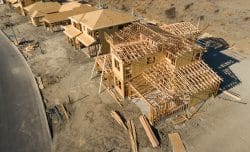
First few months – additional problems
Builders often pride themselves on how fast they can build a home; thus, saving time and money. One of the downsides of this is that framing lumber may get covered with drywall a little too fast. Resulting in nail pop ups, walls not flat because of studs twisting and bowing as they dry and occasionally mold and mildew developing in the walls.
Another problem is that if houses get wrapped (enclosed too quickly) and moisture that would normally vent to the outside during construction gets trapped inside; then the humidity level may rise significantly. In addition to this, the moisture in the air that is produced from concrete curing (losing moisture while hardening) plus the moisture released from the drywall mud hardening and moisture from paint and primers drying, gets added to the air. This may amount to 500 to 1,000 gallons of extra moisture in the air, increasing the humidity. (Check prices and features of Dehumidifiers)
Other causes for cracks, plus “truss uplift”
Other causes of cracks include poor workmanship, moisture damage from plumbing or roof leaks, structural design issues, humidity and temperature issues and seasonal causes. Additionally, truss uplift and homes that are constructed on a “Fast Track” may incur cracks.
Poor workmanship & wrong materials
Drywall that is not installed per manufactures recommended installation practices (available on various manufactures websites) is more likely to develop cracks than properly installed drywall. The same applies to using the proper type of mud and tape.
Truss Uplift
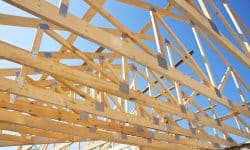
Truss uplift occurs when the bottom cord of a truss is exposed to significantly different temperatures and humidity conditions than the upper portion of the truss. This results in the bowing of the trusses which causes a gap between the top of the framed wall and the bottom of the wood trusses sitting on the wall. This gap often causes a crack in the drywall where the wall meets the ceiling. The width of the crack will vary based on the temperature, humidity, amount of insulation over the bottom cord of the truss and how the trusses are connected to the top of the interior walls and on how the drywall is attached to the ceiling and studs where the wall meets the ceiling. (Read more about truss uplift)
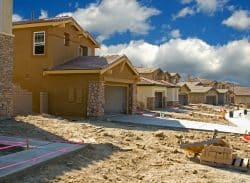
Fast Track – If a house is built too fast, then!
It’s hard to believe that if you build a house too fast, that you may be creating a few problems that are seldom thought about. Nearly everyone worries if a home is built too fast that the quality level may drop and that things will slip through the cracks that would normally not have happened; that some things may get missed or overlooked. One of these issues is with moisture.
Common types of moisture concerns
- Wood studs, ceiling joists, floor joists and other framing members of a house getting covered with drywall before the moisture content of the lumber has decreased sufficiently to prevent:
- Drywall cracking from wood shrinkage
- Mold and mildew developing because the wood was covered before it was below a moisture content level of 19%.
- Wood laminate flooring was laid before it was properly acclimated to the overall moisture level of the room or house.
- Trim, baseboard and crown molding moisture content was not acclimated to that of the house before installation.
- Flashing around chimneys and other components of the home may develop small gaps due to the shrinkage of the wood that it is attached to, thus small leaks may occur.
- Door and window issues, i.e. not closing properly or rubbing due to wood swelling, gaps in flashing, etc.
What some builders may not have accounted for when fast tracking a house is that there is a lot of moisture given off by different materials during the construction process.
- Concrete – when it cures, it gives off lots of moisture
- Lumber gives off moisture when it likewise cures
- Rain may have soaked various wood components when the house is being built
- Drywall mud for taping joints and texturing gives off moisture in the drying process
- Paint gives off moisture when it is drying
If all this moisture loss from components and the construction process doesn’t have sufficient time to dissipate properly due the fast tracking of the building process, then problems may occur.
Structural “Red Flags” to watch for
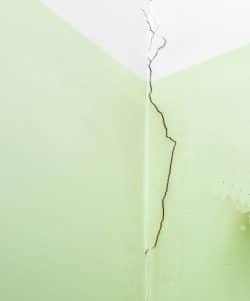
Wide cracks in drywall, especially diagonal cracks, and cracks that run through a wall and continues to run up through the ceiling are usually considered serious cracks and a sign of structural movement.
Just looking at drywall cracks themselves will not necessarily tell you if there is a structural problem.
To really know if there’s a structural problem, it is wise to look for additional indications that there are structural issues. Examples of this could be that doors and windows are sticking or rubbing, sagging or wavy roofs, cracked foundations, sagging or sloping floors, etc.
Who could help determine if there is a structural problem?
The most common professional who deals with these types of concerns would usually be a structural engineer. Having one come out to your home to do a short preliminary assessment, which might take a couple of hours, would be wise to consider.
What to do as a homeowner
First, walk around checking for drywall cracking, stains and damage, as well as possible causes. Remember to look in closets, garages and laundry rooms, you might be surprised at what you find.
Be proactive
One of the best things that a homeowner can do to prevent or reduce drywall cracking in their home is to monitor and control the humidity level of the home. Using an inexpensive digital hygrometer indoor thermometer humidity gauge or something similar is helpful.
If there are signs of moisture issues or a possible leak, further investigate and correct the problem. Testing the drywall for moisture with a pin moisture meter may help at times in knowing if there are moisture problems. If you do so, make yourself aware of what mapping is when it comes to using a moisture meter.

The majority of time small drywall cracks are not thought of as a major concern in newer homes, but in a few instances, they can be an indication of a possible structural issue.
#1 Cracks resulting from using the wrong type of drywall mud and poor workmanship in the installation of the drywall are generally not a structural concern.
#2 Ones from a home settling slightly in the first year or two are likewise normally not considered a major issue but a patching and painting type of matter.
#3 Cracks occurring because of wood shrinkage usually are not of great concern, however, in instances where the wood had a very high moisture content, then there may be some structural and mold concerns.
#4 Cracks as a result of soil and foundation issues can range from minor to major and there will usually be other evidence of structural issues besides just cracks in the drywall.
#5 When cracks appear, show the builder, ask questions and review your “Home Warranty,” including time restrictions and expiration dates in the warranty.
#6 As a homeowner it is prudent to control the humidity in your home and avoid wide seasonal swings.
#7 Monitoring all drywall cracks is one thing that every owner can do and would be wise, for if they are getting more abundant or bigger, then more consideration should be given to why and further investigation would be wise.
